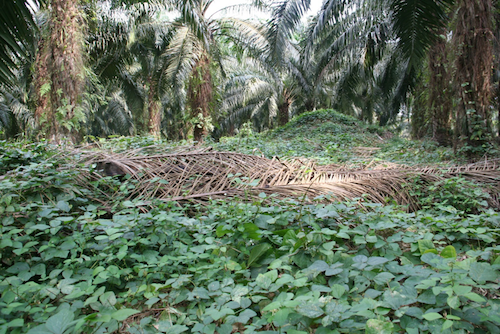Budidaya Kelapa Sawit Berkelanjutan / Penanaman tanaman penutup tanah
Unduh: Modul 3: Pemeliharaan Perkebunan
Contents
Tujuan
Membuat penutup tanah dengan menggunakan tanaman lunak secara rapat dalam area perkebunan untuk:
- Mencegah erosi tanah
- Untuk menjaga tingkat kelembaban tanah
- Mencegah hilangnya unsur hara tanah
- Menarik sebanyak mungkin predator alami musuh hama
- Memudahkan akses masuk ke dalam perkebunan
- Memudahkan dan mempercepat proses penyiangan gulma
Standarisasi
- Tanaman penutup berkualitas bagus yang ditempatkan di semua bagian di gawangan
- Penanaman tumbuhan polongan di area-area yang memungkinkan
- Tanaman yang berada di gawangan dipotong setinggi lutut
- Bebas gulma batang kayu atau jenis gulma yang merugikan lainnya di seluruh areal perkebunan
Waktu pelaksanaan
- Pada saat proses tanam, atau di awal proses rehabilitasi, setelah pembasmian gulma yang merugikan
- Tidak pada saat puncak musim hujan ataupun saat puncak musim kemarau
Frekuensi
- Pengadaan tanaman polongan sebagai penutup tanah, dilakukan hanya satu kali di sepanjang umur perkebunan
- Perawatan tanaman penutup tanah setiap 6 bulan sekali
Kebutuhan waktu tenaga kerja
- Perbaikan aplikasi fosfat: sehari per hektar
- Penaburan bibit tanaman polongan penutup tanah atau gulma lunak lainnya: 1-4 jam per hektar, tergantung dari luasnya lahan yang terbuka
- Memangkas vegetasi di area gawangan: setengah hari per hektar
Peralatan dan perlengkapan
• Pupuk fosfat: 500–-1000 kg/ha • Cangkir/ember takar untuk pupuk • Parang • Benih tanaman penutup tanah: biasanya diperlukan 1 – 2 gram per 10 meter persegi (1-2 kg per hektar)
Tenaga kerja
Petani dan keluarganya atau karyawan harian lepas
Cara pelaksanaan
Aplikasi pupuk fosfat
Jika terdapat banyak gulma merugikan di areal perkebunan (alang-alang,melastoma, dicranopteris) maka kualitas tanah akan mengalami defisiensi-fosfor. Gulma yang menguntungkan semacam pakis dan polongan dapat tumbuh lebih baik di tanah yang kaya-fosfor.
Untuk membantu pertumbuhan gulma baik dan mengurangi pertumbuhan gulma merugikan, maka penggunaan pupuk fosfat akan sangat berguna dengan penghitungan berikut:
- 500 kg/ha pupuk P cair (TSP, SP—36)
- 500—1000 kg/ha rock phosphate reaktif
Semprotkan secara merata pupuk P ke seluruh areal perkebunan, khususnya pada bagian gawangan dan gawangan mati.
Menanam tanaman polongan penutup tanah atau gulma lunak lainnya
Tabel 3: Daftar tanaman polongan penutup tanah yang paling umum digunakan di perkebunan dan beberapa sifat-sifatnya 5
| Nama | Toleransi Terhadap Keteduhan | Cara penebaran benih | Sifat lainnya |
|---|---|---|---|
| Calopogonium caeruleum | Sangat toleran | Memerlukan skarifikasi | Sangat produktif, toleran terhadap lokasi dengan tingkat keteduhan tinggi; Gambar 14 |
| Mucuna bracteata | Toleran | Memerlukan proses persemaian dan kemudian ditaman; keuntungan dari proses inokulasi | Pengikat unsur Nitrogen yang baik, penutup tanah yang baik, mencegah erosi tanah |
| Calopogonium mucunoides | Cukup toleran | Memerlukan skarifikasi | Spesies pionir; rentang hidupnya pendek |
| Pueraria phaseloides | Cukup toleran | Memerlukan skarifikasi | Pertumbuhannya cepat, sangat bisa dikonsumsi untuk ternak |
Tanaman polongan penutup tanah paling baik ditanam pada masa persiapan lahan, saat semua gulma yang ada telah dibersihkan. Jika di areal tersebut masih terdapat banyak gulma, tanaman ini akan masih bisa tumbuh, namun penyiangan selektif gulma akan menjadi sangat sulit. Di areal perkebunan dimana pembersihan gulma menjadi hal yang normal, tanaman polongan penutup tanah bisa langsung ditanam setelah proses penyemprotan. Untuk proses penaburan atau penanaman benih tanaman penutup tanah ini, ikuti langkah-langkah di bawah ini:
| Langkah 1. | Select the appropriate legume cover crop (see Table 3). They can also be mixed to increase the chances of successful establishment. |
| Langkah 2. | Scarify the seeds, if necessary. Scarification is required to remove the hard outside of the seeds, so that the seeds can germinate faster and simultaneously. Scarification can be done mechanically (with sandpaper), by using 70% sulphuric acid or by using hot water 6. The sulphuric acid method is the most common and the most effective one, but the acid may not be widely available and is a dangerous chemical, which is also difficult to dispose of after use. Therefore the mechanical scarification or the hot water treatment are recommended.
For mechanical scarification, use the following approach:
For scarification with hot water, try the following with a small batch of seeds 7:
The optimum temperature and soaking time vary from species to species; if the germination is not good, then it is recommended to try different temperatures and find out what works best |
| Langkah 3. | Broadcast the seeds in the plantation, on bare soil or in an area that was recently weeded. Start with a small area to see if the legumes are able to establish effectively. |
Apart from sowing legume cover crops, the population of Nephrolepis ferns can also be increased (Figure 15). To achieve this, pull the ferns from the trunks of the palms (roots and all) and throw them in the inter-row. Some of them may establish and start growing. The application of empty fruit bunches promotes the growth of Nephrolepis ferns.
Slashing inter-row vegetation at knee height
- Every six months slash all inter-row vegetation at knee height using a bush knife.
- Note: in some plantations it is considered a good practice to let the ferns in the frond stack area grow over 1 meter tall.
| Date | Time | Location | Activity | Input type | Input amount | Input costs | Labour input | Labour costs | |
| People | Hours | ||||||||
| 16/01/13 | Field 3 | P fertiliser application | Rock phosphate | 1000 kg | 1500000 | 2 | 4 | 80000 | |
| 20/01/13 | Field 3 | Sowing legumes | Legume seed | 2 kg | 400000 | 2 | 4 | 80000 | |
References
- ↑ Tropical Forages, Calopogonium caeruleum, http://www.tropicalforages.info/key/Forages/Media/Html/Calopogonium_caeruleum.htm, Accessed September 2013.
- ↑ Tropical Forages, Calopogonium mucunoides, http://www.tropicalforages.info/key/Forages/Media/Html/Calopogonium_mucunoides.htm, Accessed September 2013.
- ↑ Tropical Forages, Pueraria phaseoloides, http://www.tropicalforages.info/key/Forages/Media/Html/Pueraria_phaseoloides.htm, Accessed September 2013.
- ↑ Covercrops.org, 2014, Mucuna bracteata, Nadampadom Rubber Estate, Kerala, India, http://www.covercrops.org/mucunabracteata.php, Accessed September 2013.
- ↑ Sime Darby, Leguminous Cover Crop Seeds, Sime Darby Agro-Bio Sdn Bhd, Subang Jaya, Malaysia
- ↑ P.J. Argel, C.J. Paton, Overcoming legume hardseededness, in: Forage Seed Production, Volume 2, CABI Publishing, Wallingford, 1999, pp. 247—265.
- ↑ I.F. Hanum, L.J.G. Van der Maesen, PROSEA: Plant Resources of South-East Asia 11, Auxiliary Plants, Prosea Foundation, Bogor, Indonesia, 1997.
Acknowledgements
The material from Establishing a ground cover is sourced from Smallholder Oil Palm Handbook and put together by Lotte Suzanne Woittiez (Wageningen Universit) and Haryono Sadikin, Sri Turhina, Hidayat Dani, Tri Purba Dukan, and Hans Smit (SNV) in August 2016. See Module 3: Plantation Maintenance for more information.





